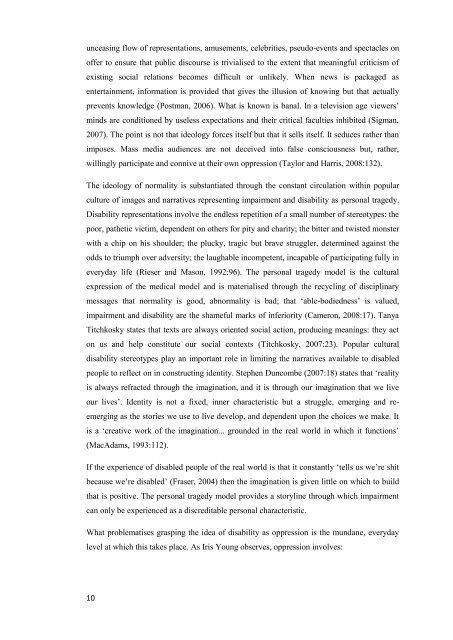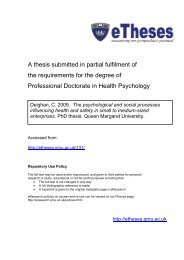A thesis submitted in partial fulfilment of - Etheses - Queen Margaret ...
A thesis submitted in partial fulfilment of - Etheses - Queen Margaret ...
A thesis submitted in partial fulfilment of - Etheses - Queen Margaret ...
You also want an ePaper? Increase the reach of your titles
YUMPU automatically turns print PDFs into web optimized ePapers that Google loves.
unceas<strong>in</strong>g flow <strong>of</strong> representations, amusements, celebrities, pseudo-events and spectacles on<br />
<strong>of</strong>fer to ensure that public discourse is trivialised to the extent that mean<strong>in</strong>gful criticism <strong>of</strong><br />
exist<strong>in</strong>g social relations becomes difficult or unlikely. When news is packaged as<br />
enterta<strong>in</strong>ment, <strong>in</strong>formation is provided that gives the illusion <strong>of</strong> know<strong>in</strong>g but that actually<br />
prevents knowledge (Postman, 2006). What is known is banal. In a television age viewers‟<br />
m<strong>in</strong>ds are conditioned by useless expectations and their critical faculties <strong>in</strong>hibited (Sigman,<br />
2007). The po<strong>in</strong>t is not that ideology forces itself but that it sells itself. It seduces rather than<br />
imposes. Mass media audiences are not deceived <strong>in</strong>to false consciousness but, rather,<br />
will<strong>in</strong>gly participate and connive at their own oppression (Taylor and Harris, 2008:132).<br />
The ideology <strong>of</strong> normality is substantiated through the constant circulation with<strong>in</strong> popular<br />
culture <strong>of</strong> images and narratives represent<strong>in</strong>g impairment and disability as personal tragedy.<br />
Disability representations <strong>in</strong>volve the endless repetition <strong>of</strong> a small number <strong>of</strong> stereotypes: the<br />
poor, pathetic victim, dependent on others for pity and charity; the bitter and twisted monster<br />
with a chip on his shoulder; the plucky, tragic but brave struggler, determ<strong>in</strong>ed aga<strong>in</strong>st the<br />
odds to triumph over adversity; the laughable <strong>in</strong>competent, <strong>in</strong>capable <strong>of</strong> participat<strong>in</strong>g fully <strong>in</strong><br />
everyday life (Rieser and Mason, 1992:96). The personal tragedy model is the cultural<br />
expression <strong>of</strong> the medical model and is materialised through the recycl<strong>in</strong>g <strong>of</strong> discipl<strong>in</strong>ary<br />
messages that normality is good, abnormality is bad; that „able-bodiedness‟ is valued,<br />
impairment and disability are the shameful marks <strong>of</strong> <strong>in</strong>feriority (Cameron, 2008:17). Tanya<br />
Titchkosky states that texts are always oriented social action, produc<strong>in</strong>g mean<strong>in</strong>gs: they act<br />
on us and help constitute our social contexts (Titchkosky, 2007:23). Popular cultural<br />
disability stereotypes play an important role <strong>in</strong> limit<strong>in</strong>g the narratives available to disabled<br />
people to reflect on <strong>in</strong> construct<strong>in</strong>g identity. Stephen Duncombe (2007:18) states that „reality<br />
is always refracted through the imag<strong>in</strong>ation, and it is through our imag<strong>in</strong>ation that we live<br />
our lives‟. Identity is not a fixed, <strong>in</strong>ner characteristic but a struggle, emerg<strong>in</strong>g and re-<br />
emerg<strong>in</strong>g as the stories we use to live develop, and dependent upon the choices we make. It<br />
is a „creative work <strong>of</strong> the imag<strong>in</strong>ation... grounded <strong>in</strong> the real world <strong>in</strong> which it functions‟<br />
(MacAdams, 1993:112).<br />
If the experience <strong>of</strong> disabled people <strong>of</strong> the real world is that it constantly „tells us we‟re shit<br />
because we‟re disabled‟ (Fraser, 2004) then the imag<strong>in</strong>ation is given little on which to build<br />
that is positive. The personal tragedy model provides a storyl<strong>in</strong>e through which impairment<br />
can only be experienced as a discreditable personal characteristic.<br />
What problematises grasp<strong>in</strong>g the idea <strong>of</strong> disability as oppression is the mundane, everyday<br />
level at which this takes place. As Iris Young observes, oppression <strong>in</strong>volves:<br />
10




